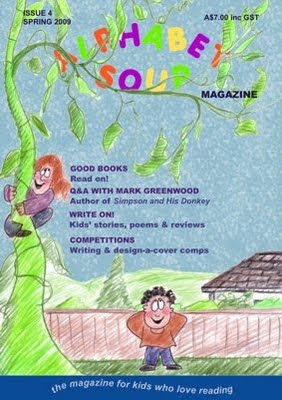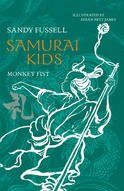 Welcome to Writing Children's Books with Robyn Opie. Today we have a special guest, Rebecca Newman, Alphabet Soup's publisher and editor.
Welcome to Writing Children's Books with Robyn Opie. Today we have a special guest, Rebecca Newman, Alphabet Soup's publisher and editor.Here is a little information about Alphabet Soup and their spring issue from Rebecca Newman. Thanks, Rebecca.
Alphabet Soup is an Australian magazine for children aged 6 to 12 who love reading and creative writing. We're thrilled that the spring 2009 issue is here - it marks our first birthday! A year (4 issues!) has gone very quickly.
Inside the spring 2009 issue of Alphabet Soup:

* Q&A with Mark Greenwood, author of Simpson and His Donkey
* stories and poems by adults and children
* meet a family growing vegies in their garden
* tips for honing your writing skills
* book reviews
* children's writing competition
* design-a-cover competition.
A free sample of the magazine (issue 1) can be downloaded from our website: http://www.alphabetsoup.net.au
As part of our blog tour to celebrate our first birthday, we're giving away the first 4 issues of Alphabet Soup. Keep reading to learn how you can win.
But first here are 5 things you might not know about Alphabet Soup magazine:
1) The magazine is published in Perth, Western Australia.
2) As the magazine is highly illustrated (and we don’t use many photographs), we print the magazine on ‘satin’ paper, rather than gloss. Sometimes glossy paper is harder to read, due to the light reflecting off the glossy finish. (We don’t want our readers to have tired eyes!)
3) Children do not have to subscribe to the magazine to enter our competitions. (We run a writing competition in each issue. We are currently running a design-a-cover competition too, and this closes on 16 September 2009.)
4) The original logo was designed by Lucas Ihlein using alphabet pasta. While he was brainstorming ideas for the logo, he made a 13 second video (which you can view on Alphabet Soup’s Facebook page - http://www.facebook.com/video/?id=27726653438). A later version of the logo used coloured alphabet pasta. Then he passed it along to Chris Farrell, who ‘flattened’ the image – to turn it into the logo we know and love!
5) You can stay up to date with our kids’ writing competitions and other news by subscribing to our free e-newsletter. (Parents can sign up for it by sending an email to: editor@alphabetsoup.net.au with ‘subscribe e-newsletter’ in the subject header.)
Now, to the competition.
One lucky person can win the first 4 issues of Alphabet Soup. Please answer the following question, then email your answer and your name to: robyn@robynopie.com.
Q: In which Australian state is Alphabet Soup published?
Remember to email your answer and your name to robyn@robynopie.com. Thanks for being a part of our first year celebrations. We hope to see you again next year for our second birthday!
Thanks for visiting my blog, Rebecca, and for offering a wonderful prize for a lucky reader. Who will it be?
Good luck!
And best wishes,
Robyn Opie
http://www.robynopie.com










